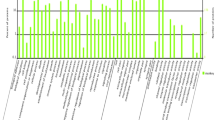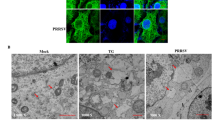Abstract
Porcine reproductive and respiratory syndrome virus (PRRSV) causes significant economic losses for the swine industry worldwide. The PRRSV E protein, encoded by ORF 2b, is one of the non-glycosylated minor structural proteins. In this study, we present evidence for the interaction of the E protein with mitochondrial proteins ATP5A (part of ATP synthase complex), prohibitin, and ADP/ATP translocase. We additionally demonstrate partial mitochondrial localization of the E protein in transfected cells. To functionally investigate these interactions, we infected MARC-145 cells with PRRSV or alphavirus replicon particles (VRPs) expressing PRRSV E protein. In infected cells, production of ATP was significantly reduced. The E protein also induced apoptosis by activating caspase-3, which results in PARP cleavage. Taken together, these data suggest that the PRRSV E protein interacts with mitochondrial proteins and induces apoptosis by inhibiting ATP production.





Similar content being viewed by others
References
Abu-Hamad S, Sivan S, Shoshan-Barmatz V (2006) The expression level of the voltage-dependent anion channel controls life and death of the cell. Proceedings of the National Academy of Sciences of the United States of America 103:5787–5792
Anand SK, Tikoo SK (2013) Viruses as modulators of mitochondrial functions. Adv Virol 2013:738794
Atkins GJ, Fleeton MN, Sheahan BJ (2008) Therapeutic and prophylactic applications of alphavirus vectors. Expert Rev Mole Med 10:e33
Aweya JJ, Mak TM, Lim SG, Tan YJ (2013) The p7 protein of the hepatitis C virus induces cell death differently from the influenza A virus viroporin M2. Virus Res 172:24–34
Beauchamp E, Tekpli X, Marteil G, Lagadic-Gossmann D, Legrand P, Rioux V (2009) N-Myristoylation targets dihydroceramide Delta4-desaturase 1 to mitochondria: partial involvement in the apoptotic effect of myristic acid. Biochimie 91:1411–1419
Bradbury DA, Simmons TD, Slater KJ, Crouch SP (2000) Measurement of the ADP:ATP ratio in human leukaemic cell lines can be used as an indicator of cell viability, necrosis and apoptosis. J Immunol Methods 240:79–92
Butler JE, Lager KM, Golde W, Faaberg KS, Sinkora M, Loving C, Zhang YI (2014) Porcine reproductive and respiratory syndrome (PRRS): an immune dysregulatory pandemic. Immunol Res 59:81–108
Colombo S, Longhi R, Alcaro S, Ortuso F, Sprocati T, Flora A, Borgese N (2005) N-myristoylation determines dual targeting of mammalian NADH-cytochrome b5 reductase to ER and mitochondrial outer membranes by a mechanism of kinetic partitioning. J Cell Biol 168:735–745
Du Y, Zuckermann FA, Yoo D (2010) Myristoylation of the small envelope protein of porcine reproductive and respiratory syndrome virus is non-essential for virus infectivity but promotes its growth. Virus research 147:294–299
Eguchi Y, Shimizu S, Tsujimoto Y (1997) Intracellular ATP levels determine cell death fate by apoptosis or necrosis. Cancer Res 57:1835–1840
Fernandez A, Suarez P, Castro JM, Tabares E, Diaz-Guerra M (2002) Characterization of regions in the GP5 protein of porcine reproductive and respiratory syndrome virus required to induce apoptotic cell death. Virus Res 83:103–118
Griffin SD, Harvey R, Clarke DS, Barclay WS, Harris M, Rowlands DJ (2004) A conserved basic loop in hepatitis C virus p7 protein is required for amantadine-sensitive ion channel activity in mammalian cells but is dispensable for localization to mitochondria. J General Virol 85:451–461
Jacotot E, Ferri KF, El Hamel C, Brenner C, Druillennec S, Hoebeke J, Rustin P, Metivier D, Lenoir C, Geuskens M, Vieira HL, Loeffler M, Belzacq AS, Briand JP, Zamzami N, Edelman L, Xie ZH, Reed JC, Roques BP, Kroemer G (2001) Control of mitochondrial membrane permeabilization by adenine nucleotide translocator interacting with HIV-1 viral protein rR and Bcl-2. J Exp Med 193:509–519
Kim HS, Kwang J, Yoon IJ, Joo HS, Frey ML (1993) Enhanced replication of porcine reproductive and respiratory syndrome (PRRS) virus in a homogeneous subpopulation of MA-104 cell line. Arch Virol 133:477–483
Lee C, Rogan D, Erickson L, Zhang J, Yoo D (2004) Characterization of the porcine reproductive and respiratory syndrome virus glycoprotein 5 (GP5) in stably expressing cells. Virus Res 104:33–38
Lee C, Yoo D (2006) The small envelope protein of porcine reproductive and respiratory syndrome virus possesses ion channel protein-like properties. Virol 355:30–43
Lee SM, Kleiboeker SB (2007) Porcine reproductive and respiratory syndrome virus induces apoptosis through a mitochondria-mediated pathway. Virology 365:419–434
Ma Z, Wang Y, Zhao H, Xu AT, Tang J, Feng WH (2013) Porcine reproductive and respiratory syndrome virus nonstructural protein 4 induces apoptosis dependent on its 3C-like serine protease activity. PloS One 8:e69387
Mu Y, Li L, Zhang B, Huang B, Gao J, Wang X, Wang C, Xiao S, Zhao Q, Sun Y, Zhang G, Hiscox JA, Zhou EM (2015) Glycoprotein 5 of porcine reproductive and respiratory syndrome virus strain SD16 inhibits viral replication and causes G2/M cell cycle arrest, but does not induce cellular apoptosis in Marc-145 cells. Virology 484:136–145
Nelsen CJ, Murtaugh MP, Faaberg KS (1999) Porcine reproductive and respiratory syndrome virus comparison: divergent evolution on two continents. J Virol 73:270–280
Nijtmans LG, de Jong L, Artal Sanz M, Coates PJ, Berden JA, Back JW, Muijsers AO, van der Spek H, Grivell LA (2000) Prohibitins act as a membrane-bound chaperone for the stabilization of mitochondrial proteins. EMBO J 19:2444–2451
Rahmani Z, Huh KW, Lasher R, Siddiqui A (2000) Hepatitis B virus X protein colocalizes to mitochondria with a human voltage-dependent anion channel, HVDAC3, and alters its transmembrane potential. J Virol 74:2840–2846
Shoshan-Barmatz V, Israelson A, Brdiczka D, Sheu SS (2006) The voltage-dependent anion channel (VDAC): function in intracellular signalling, cell life and cell death. Curr Pharm Des 12:2249–2270
Sirinarumitr T, Zhang Y, Kluge JP, Halbur PG, Paul PS (1998) A pneumo-virulent United States isolate of porcine reproductive and respiratory syndrome virus induces apoptosis in bystander cells both in vitro and in vivo. J General Virol 79(Pt 12):2989–2995
Snijder EJ, Kikkert M, Fang Y (2013) Arterivirus molecular biology and pathogenesis. J General Virol 94:2141–2163
Suarez P, Diaz-Guerra M, Prieto C, Esteban M, Castro JM, Nieto A, Ortin J (1996) Open reading frame 5 of porcine reproductive and respiratory syndrome virus as a cause of virus-induced apoptosis. J Virol 70:2876–2882
Veit M, Matczuk AK, Sinhadri BC, Krause E, Thaa B (2014) Membrane proteins of arterivirus particles: structure, topology, processing and function. Virus Res 194:16–36
Volkova E, Gorchakov R, Frolov I (2006) The efficient packaging of Venezuelan equine encephalitis virus-specific RNAs into viral particles is determined by nsP1-3 synthesis. Virology 344:315–327
Wang X, Li C, Zhou L, Zhang N, Ge X, Guo X, Yang H (2014) Porcine reproductive and respiratory syndrome virus counteracts the porcine intrinsic virus restriction factors-IFITM1 and Tetherin in MARC-145 cells. Virus Res 191:92–100
Wissink EH, Kroese MV, van Wijk HA, Rijsewijk FA, Meulenberg JJ, Rottier PJ (2005) Envelope protein requirements for the assembly of infectious virions of porcine reproductive and respiratory syndrome virus. J Virol 79:12495–12506
Wu WH, Fang Y, Farwell R, Steffen-Bien M, Rowland RR, Christopher-Hennings J, Nelson EA (2001) A 10-kDa structural protein of porcine reproductive and respiratory syndrome virus encoded by ORF2b. Virology 287:183–191
Wu WH, Fang Y, Rowland RR, Lawson SR, Christopher-Hennings J, Yoon KJ, Nelson EA (2005) The 2b protein as a minor structural component of PRRSV. Virus Res 114:177–181
Yu M, Liu X, Sun L, Chen C, Ma G, Kitamura Y, Gao GF, Liu W (2010) Subcellular localization and topology of porcine reproductive and respiratory syndrome virus E protein. Virus Res 152:104–114
Zamarin D, Garcia-Sastre A, Xiao X, Wang R, Palese P (2005) Influenza virus PB1-F2 protein induces cell death through mitochondrial ANT3 and VDAC1. PLoS Pathog 1:e4
Zhang K, Hou Q, Zhong Z, Li X, Chen H, Li W, Wen J, Wang L, Liu W, Zhong F (2013) Porcine reproductive and respiratory syndrome virus activates inflammasomes of porcine alveolar macrophages via its small envelope protein E. Virology 442:156–162
Acknowledgments
We thank Dr. Ilya V. Frolov (University of Alabama) for providing plasmids to make VEE VRPs, and Mr. Yurij Popowych for help with flow cytometry analysis. We are thankful to the Saskatchewan Ministry of Agriculture (Agriculture Development Fund) for financial support. This paper was published with the permission of the Director of VIDO-InterVac, journal series no. 755.
Author information
Authors and Affiliations
Corresponding author
Ethics declarations
Funding
The study was funded in part by funding from the Saskatchewan Ministry of Agriculture (ANZ is a principal investigator).
Conflict of interest
The authors declare that they have no conflict of interest.
Ethical approval
This article does not contain any studies with human participants or animals performed by any of the authors.
Electronic supplementary material
Below is the link to the electronic supplementary material.
Rights and permissions
About this article
Cite this article
Pujhari, S., Zakhartchouk, A.N. Porcine reproductive and respiratory syndrome virus envelope (E) protein interacts with mitochondrial proteins and induces apoptosis. Arch Virol 161, 1821–1830 (2016). https://doi.org/10.1007/s00705-016-2845-4
Received:
Accepted:
Published:
Issue Date:
DOI: https://doi.org/10.1007/s00705-016-2845-4




